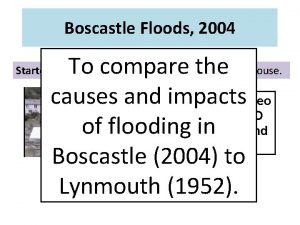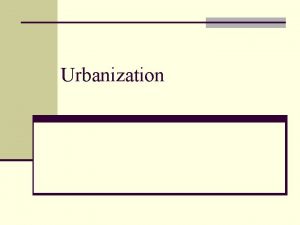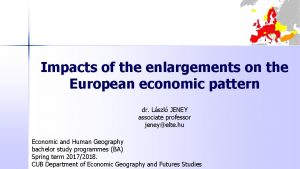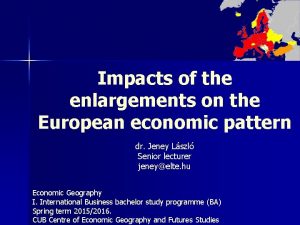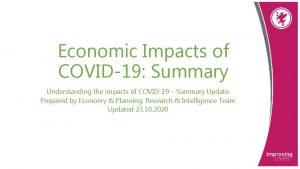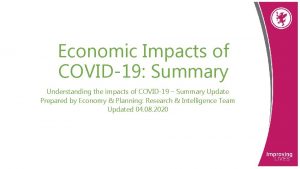Impacts of the enlargements on the European economic
















- Slides: 16

Impacts of the enlargements on the European economic pattern dr. Jeney László Senior lecturer jeney@elte. hu Economic Geography I. International Business bachelor study programme (BA) Autumn term 2015/2016. CUB Department of Economic Geography and Futures Studies

Impacts of the enlargements on the European economic pattern

Effects of East Accession n 13 countries wanted to access More underdeveloped ones Widening and deepening at the same time: – Community achievements (acquis communautaire) should remain – EU should remain being able to be financed n n Area increased with 34%, agricultural land area 50%, pop. 29%, agricultural producers 100%, GDP 9% Per capita GDP: decreased with 16% – Institutional bodies should function 3

Impacts of enlargements Growth in % Area Population GDP Per capita GDP 4

Position of EU in relation to the other cores Area km 2 GDP PPP Per cap GDP PPP Export US $ Import US $ 490 mn WR 3 14, 82 bn 32700 WR 1 WR 31 1, 95 bn WR 1 1, 69 bn WR 2 310 mn WR 4 14, 66 bn 47200 WR 2 WR 10 1, 29 bn WR 3 1, 94 bn WR 1 Japan 380 th WR 60 130 mn WR 11 4, 31 bn WR 4 0, 76 bn WR 4 0, 64 bn WR 4 China 9, 6 mn WR 4 1300 mn 10, 09 bn 7600 WR 1 WR 3 WR 100 1, 58 bn WR 2 1, 33 bn WR 3 EU USA 4, 3 mn WR 7 Population persons 9, 8 mn WR 3 34000 WR 28

The pattern of European economy 6

Shifting of the economic Core 7

Geogrpahical concentration of the economy still remained in the Core Economic development: GDP per capita Economic density: area GDP per area 8

The European Pentagon/Core – Area: 20% – Population: 40% – GDP: 50% Cities over 500. 000 residents: – – population: 20% GDP: 29% GDP/cap. : 141% GDP-growth: faster with +8%point 9

Economic Importance of Cities in North America n Economic development measured only with per capita GDP – – n At current market prices in € Examined area: V 4 Countries (CZ, HU, PL, SK) Examined regional level: NUTS 3 Examined period: 1995– 2004 Data source: Eurostat http: //epp. eurostat. ec. europa. eu/ Proportion of cities in Canada/USA country population GDP USA (SMA) 38% 49% Canada (CMA) 45% 54% 10

Growing Importance of Cities in European Economic Pattern Studying success of cities becomes a key issue for current European regional trends and regional policy Most of the cities over average Economic Development State of Cities and Rural Regions Related to their National Average, 2004. Some countries: only the cities are over average (e. g. V 4) Some countries: other inequality factors are more important (Germany, Italy, Romania, Spain) 11

Differences of Urban–Rural Duality in Member States of EU, 2004 Cities over 500. 000 residents: population: 20% GDP: 29% GDP/cap. : 141% GDP-growth: faster with +8%point Measuring Urban–Rural Duality DUR: urban–rural duality index x. U: average per capita GDP of cities in a country x. R: average per capita GDP of rural regions in a country Source of data: Eurostat, basis of map: World Gazetteer 12

Relationship Between State of Development and Urban–Rural Duality for EU Members, 2004 Source of data: Euro. Stat 13

Post-socialist countries: characterized with growing urban– rural dualism Source of data: Euro. Stat n n Chiefly the outstanding of capitals More remarkable in case of underdeveloped, catching-up V 4 countries than older members Change of Urban–Rural Duality in EU Member States, 1995– 2004 14

Post-socialist cities are to join to the 2 nd level of European citynetwork n n Post-socialist cities: new development wave (similar to Southern Periphery) based chiefly on international investments New European models on Peripheries should adjust the classic urban zone of Blue Banana – Sunbelt or (Golden Banana) – Central European Boomerang) 15

V 4: success of cities not independent of the shift of their sectoral structure n V 4: success of cities not independent of the shift of their sectoral structure – – Increase of urban–rural inequality is mainly tertiary based Industrial renewal hide in the background of fine differences among rural regions Agriculture Industry Services Cities 1995– 2004. 1. 3 1. 8 2. 6 Rural regions 1995– 2004. 1. 3 1. 9 2. 1 Growth Indexes of Gross Value Added (GVA) in the Sectors in V 4 Countries, 1995– 2004. 16
 Negative and fractional enlargements
Negative and fractional enlargements Innervations of the brachial and lumbar enlargements
Innervations of the brachial and lumbar enlargements Advantages of logging
Advantages of logging European exploration economic reasons
European exploration economic reasons Conclusion of growth and development
Conclusion of growth and development Economic systems lesson 2 our economic choices
Economic systems lesson 2 our economic choices Economic growth vs economic development
Economic growth vs economic development When was the loom invented
When was the loom invented What caused the boscastle flood
What caused the boscastle flood Disadvantages of commercialization of sports
Disadvantages of commercialization of sports Positive impacts of tourism in scotland
Positive impacts of tourism in scotland Impacts of imperialism
Impacts of imperialism Situational irony in the pardoner's tale
Situational irony in the pardoner's tale Science and technology
Science and technology Socio-cultural impacts
Socio-cultural impacts Long term impacts of the industrial revolution
Long term impacts of the industrial revolution Impacts of climate change
Impacts of climate change








